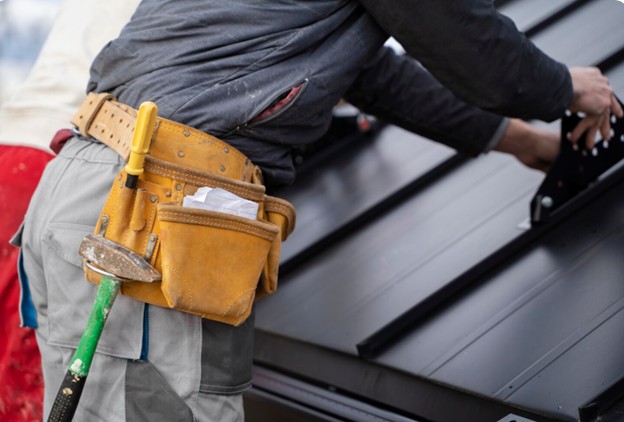Coordinating siding installation with exterior painting requires careful planning to achieve optimal results while avoiding unnecessary costs and delays. The sequence of these projects affects everything from material protection to labor efficiency, making proper scheduling essential for successful home exterior improvements. Knowing about the factors that influence project sequencing helps homeowners make informed decisions that save time and money.
Complete Siding Replacement Projects
When installing new siding over the entire house exterior, siding installation should precede any exterior painting work. New siding materials typically come pre-primed or pre-finished, requiring minimal additional painting beyond trim work and accent areas. Installing siding first protects the underlying structure and provides a clean foundation for any supplementary painting needs.
Siding installation involves cutting, fitting, and fastening materials that create sawdust, debris, and possible scratches or damage to painted surfaces. Completing this work before exterior painting eliminates the risk of damaging freshly painted areas during the installation process.
Weather protection improves significantly once siding installation is complete. The new weather barrier allows exterior painting of trim, windows, and doors to proceed under better conditions, with reduced risk of moisture infiltration during the painting process.
Partial Siding Projects & Repairs
Partial siding installation projects require more careful coordination with exterior painting schedules. When replacing sections of damaged siding while maintaining existing materials elsewhere, the painting sequence depends on the condition and color of surrounding areas.
New siding sections rarely match the weathered appearance of existing materials, even when using identical products. This color variation often necessitates exterior painting of the entire wall or building section to achieve uniform appearance. In these cases, siding installation should precede painting work.
Repairs to existing siding may require spot priming and painting before new sections are installed. This approach ensures proper protection of repaired areas and creates better color matching opportunities when the final exterior painting is completed.
Trim Work & Detail Coordination
Window and door trim installation typically occurs after siding installation is complete but before final exterior painting begins. This sequence allows for proper caulking and sealing between siding and trim components, creating weather-tight installations that perform better over time.
Fascia boards, soffits, and other architectural details should be installed and primed before siding installation when possible. These components are easier to access and finish properly before siding creates obstacles or tight spaces that complicate painting work.
Corner boards and trim pieces that integrate with siding systems require coordination between installers and painters. Some trim components need priming before installation, while others can be painted after all assembly work is complete.
Weather Considerations & Timing
Seasonal timing affects the optimal sequence for siding installation and exterior painting projects. Spring and fall typically provide the best conditions for both types of work, but scheduling conflicts may require adjusting the typical sequence.
Siding installation can proceed in cooler temperatures and light rain conditions that would prevent quality exterior painting work. This weather tolerance makes siding installation a logical first step during marginal weather periods.
Exterior painting requires specific temperature and humidity conditions for proper application and curing. Delaying painting until optimal conditions exist often produces better results than rushing to complete work in poor weather.
Surface Preparation Requirements
Existing paint conditions influence the logical sequence for siding installation and exterior painting projects. Buildings with failing paint may require extensive scraping and preparation work that could damage new siding materials if completed afterward.
Power washing removes dirt, mildew, and loose paint that could interfere with both siding installation and paint adhesion. This preparation work should typically be completed before beginning either project, allowing adequate drying time for optimal conditions.
Primer application on bare wood surfaces should occur promptly after exposure to prevent moisture absorption and possible damage. Coordinating these protection needs with siding installation schedules prevents delays and material problems.
Material Protection & Quality Control
Protecting new siding materials during exterior painting work requires careful planning and additional labor costs. Masking, covering, or removing siding sections for painting access adds difficulty and expense that proper sequencing can eliminate.
Paint overspray and drips can damage or stain new siding materials, particularly textured or porous surfaces. Completing siding installation after exterior painting eliminates these risks and reduces the preparation time needed for painting work.
Quality control becomes easier when each project can be completed and inspected before beginning the next phase. This approach allows for corrections and touch-ups without interference from subsequent work activities.
Cost Implications & Budget Planning
Labor efficiency improves when projects are sequenced logically, reducing overall costs for both siding installation and exterior painting work. Contractors can work more efficiently when not constrained by protecting completed work from other trades.
Material waste decreases when proper sequencing prevents damage to completed work. Paint and siding materials damaged during construction must be replaced, adding costs that proper planning can avoid.
Scheduling flexibility improves when projects can be completed independently rather than requiring coordination between multiple contractors working simultaneously on the same surfaces.
Contractor Coordination & Communication
Single contractors capable of both siding installation and exterior painting can sequence work optimally for specific project conditions. This approach eliminates coordination challenges and conflicts between separate contractors.
Clear communication between separate contractors ensures proper sequencing and prevents conflicts over work areas, material storage, and access requirements. Written agreements should specify responsibilities and sequencing requirements.
Quality warranties may be affected by work sequencing, particularly when damage occurs between project phases. Knowing about warranty implications helps homeowners make informed decisions about contractor selection and project timing.
Special Circumstances & Exceptions
Historic properties may require specific sequencing to comply with preservation guidelines or local regulations. Some restoration projects require exterior painting before siding installation to maintain historical accuracy or meet regulatory requirements.
Emergency repairs sometimes necessitate immediate siding installation regardless of painting schedules. Protecting the building envelope takes priority over optimal sequencing when weather damage or structural issues create urgent needs.
Budget constraints may influence sequencing decisions when homeowners cannot afford both projects simultaneously. Completing siding installation first provides weather protection while allowing exterior painting to be deferred until funding becomes available.
Long-term Maintenance Planning
Future maintenance requirements should influence initial sequencing decisions. Siding materials with long lifespans may outlast several exterior painting cycles, making installation first more logical for long-term maintenance planning.
Color coordination between siding and painted elements works better when final paint selections can be made after siding installation is complete. This approach ensures optimal color matching and design cohesion.
Warranty periods for both siding installation and exterior painting work may overlap, requiring documentation of project sequences and any interactions between systems. Proper sequencing helps prevent warranty disputes and ensures coverage remains valid.
The optimal sequence for siding installation and exterior painting depends on project scope, weather conditions, material types, and budget considerations. Generally, siding installation should precede exterior painting to protect new paint work and allow for better quality control, but specific circumstances may require alternative approaches for best results.

